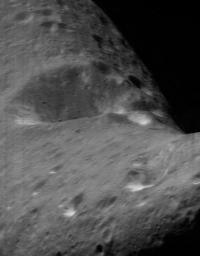
|
Impact at High Noon
- Click the image above for a larger view
- Full-Res JPEG (372 x 477) (19.0 kB)
- Full-Res TIFF (372 x 477) (128.4 kB)
Caption:
For people who live in mountain valleys, daylight can be a short-lived experience. Mountains to the east make the Sun rise later in the morning, while mountains to the west make the Sun set earlier in the evening. The brevity of daytime in a valley is accentuated during the shortened days of winter.
The floor of the 5.5-kilometer (3.4-mile) diameter impact crater that dominates one face of Eros experiences the ultimate in short daylight hours. Three factors conspire to make this true. Firstly, Eros rotates rapidly, once every 5.27 hours. Secondly, the crater's 0.9-kilometer (0.56-mile) high walls tend to block direct sunlight from the floor, even while the outside of the crater is illuminated. Thirdly, during the current season on Eros, the Sun never makes it high in the sky in this location.
This NEAR Shoemaker image, taken April 1, 2000, from a range of 209 kilometers (130 miles), caught the crater near local noon with the Sun highest in the sky. On that day, a hardy astronaut standing at the bottom of the crater would have experienced 1 hour and 45 minutes of daylight.
Background Info:
Built and managed by The Johns Hopkins University Applied Physics Laboratory, Laurel, Maryland, NEAR was the first spacecraft launched in NASA's Discovery Program of low-cost, small-scale planetary missions. See the NEAR web page at http://near.jhuapl.edu/ for more details.
Cataloging Keywords:
| Name | Value | Additional Values |
|---|---|---|
| Target | 433 Eros | |
| System | Near Earth Objects | |
| Target Type | Asteroid | |
| Mission | NEAR Shoemaker | |
| Instrument Host | NEAR Shoemaker | |
| Host Type | Orbiter | |
| Instrument | Multi-Spectral Imager (MSI) | |
| Detector | ||
| Extra Keywords | Crater, Grayscale, Impact, Mountain, Rotation | |
| Acquisition Date | ||
| Release Date | 2000-06-10 | |
| Date in Caption | 2000-04-01 | |
| Image Credit | NASA/JPL/JHUAPL | |
| Source | photojournal.jpl.nasa.gov/catalog/PIA02499 | |
| Identifier | PIA02499 | |
